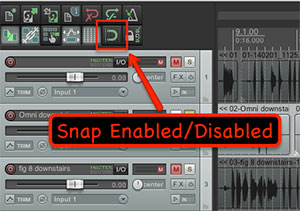 The Reaper blog just published a post about a setting I didn’t know about, and it really helps me a lot! It’s called the “Snap Relative to Grid” setting. In a lot of my tutorials, I warn people to pay attention to whether the Snap tool (looks like a magnet – see the pic on the left) is enabled or disabled. It’s incredibly useful when you want to snap the edges of your item to a gridline (which can be bars/beats, or minutes/seconds, etc.). But if you are trying to nudge something just a bit to the left or right on a track, having the Snap tool enabled will be trouble.
The Reaper blog just published a post about a setting I didn’t know about, and it really helps me a lot! It’s called the “Snap Relative to Grid” setting. In a lot of my tutorials, I warn people to pay attention to whether the Snap tool (looks like a magnet – see the pic on the left) is enabled or disabled. It’s incredibly useful when you want to snap the edges of your item to a gridline (which can be bars/beats, or minutes/seconds, etc.). But if you are trying to nudge something just a bit to the left or right on a track, having the Snap tool enabled will be trouble.
One problem I run into quite a bit is when I am dragging a bit of audio from one track to another. I don’t have a very steady hand (so you don’t want me doing brain surgery on you :)), so I almost always manage to slip the audio a bit left or right when I am just trying to drag it up or down. Of course, this will mess up the timing, and I often find myself undoing (“ctrl-z” is the best keyboard shortcut EVER) and trying again. Or I drag the edge of the audio item out beyond its actual start or stop time to get it to line up with a gridline, then turn on the Snap tool, then drag it up, then turn off the Snap tool. Craziness, I know! In my mind, I knew there was a way to keep the audio aligned in time while dragging to a different track, but I’m lazy, so I never looked it up.
Well, it turns out the answer is “Snap Relative to Grid.” You just go to the Snap/Grid settings (right-mouse click on the Snap tool) and put a check mark in the “Snap relative to Grid” box. That way, if the edges of your audio happen to fall between gridlines, and you want to drag the audio up to a different track, the edges will stay aligned with however far away the audio was from the nearest gridline to start with. In a nutshell, this means you can drag your audio clip up to a different track without worrying about it slipping left or right (earlier or later in time) in the process. In other words, it’s the right tool for the job I’ve been doing the hard way for years. Yay!
Here is Reaper’s blog post about it, along with an animation that shows you both how to select the option and what it does for your audio item when dragging it up or down to a different track. Hope this makes you as happy as it makes me :). http://reaperblog.net/2014/10/reaper-faq-what-does-snap-relative-to-grid-mean/
Hey Ken! You just gave me an idea for another article, re: moving tracks up and down without losing the time position. Hint – mouse modifiers.
Awesome! I love learning about these little things that make such a huge impact on workflow in the studio! Thanks for the post and I’m so glad I could inspire yet another tip:)!
Cheers!
Ken
There is also a command in the actions list called “Item edit: move items/envelope up one track/a bit” which I use all the time instead of dragging by hand. No worries about left/right movement at all with this shortcut. (There is a “move items down” action as well.)
Very handy for comping takes.
Thanks John!
Highlight item press key 8 to move up 2 to move it down a track
Thanks Anton. so what do you mean by “key 8” and “key 2”? Because just hitting those number keys doesn’t do anything. Neither does F2 or F8.
Sorry for taking so long to get back only there is no function here to show when there is a new message.
My key 8 to move up and key 2 reference is applicable the situation you have shown where you are repairing a mistake. So you want to copy a good part in a tune to replace a bad part. You cut out the good part, paste it in new track below or above the track with the bad part. Cut out the bad part and then highlight the item on the new track (the good part) and press key 8 or 2 (on the number pad at the left-hand side of the keyboard not the numbers on top) to move the item up or down into the space you have in the track you have above or below the item on the new track. In fact 8 or 2 moves up or down through all the tracks if you keep pushing.
I hope that makes some sense!
It does. Thanks. I can’t wait to try it out.